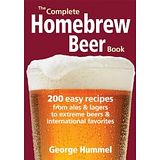 The title of this book is ambitious, and the author’s credentials are certainly impressive enough to back up the book's claim to completeness. George Hummel is a home brewer and writer from Philadelphia. His shop, Homebrew Sweet Homebrew, has been located in the city since 1986 and both his beers and writing have won numerous awards. Don’t be fooled by the title though, this book is not a complete guide to the art of brewing aimed at the established brewer. Instead, it’s aimed very much at the novice brewer. Simple and accessible, it focuses exclusively on extract brewing. With 200 recipes from ales and lagers to extreme beers and even ginger ale, George Hummel may have written the complete guide to extract home-brewing.
The title of this book is ambitious, and the author’s credentials are certainly impressive enough to back up the book's claim to completeness. George Hummel is a home brewer and writer from Philadelphia. His shop, Homebrew Sweet Homebrew, has been located in the city since 1986 and both his beers and writing have won numerous awards. Don’t be fooled by the title though, this book is not a complete guide to the art of brewing aimed at the established brewer. Instead, it’s aimed very much at the novice brewer. Simple and accessible, it focuses exclusively on extract brewing. With 200 recipes from ales and lagers to extreme beers and even ginger ale, George Hummel may have written the complete guide to extract home-brewing.
The focus is very much on extract brewing, and the author uses extract brewing as the entry point to home brewing with some simple recipes that are little more complicated than the steps required for kit brewing, before guiding the reader through how to enhance extract brews by using liquid yeasts and techniques such as grain steeping. Reassuringly for those new to brewing, several handy tools such as a guide to the characteristics of an extensive number of American and European leaf hops, and a gentle overview of the types of malted grains available to home brewers, are as complicated as this book gets.
Each recipe gets a 2 page spread dedicated to it, so there’s no need to turn pages on brew day – a nice practical touch that this reviewer found useful. The amount of brewing water, malt extract, bittering hops, latter additions, aroma hops and yeast are all listed in a table at the start. The brewing instructions are then laid out step by step in a clear easy to read format. Brewing tips, recipe-specific equipment and possible alterations to the recipe are presented in side panels.
The book is divided into 3 distinct parts:
• Part 1: ‘Homebrewing for Beginners’.
This section consists of 31 pages of clear, simple instructions for producing extract beers aimed at absolute beginners, concluding with a handy step by step overview of the brew day and a number of ‘basic’ recipes to try.
• Part 2: ‘Taking Your Brewing Skills to the Next Level’.
The second part of the book introduces malted grains, leaf hops and liquid yeasts before using them to create more complex recipes than those found earlier in the book. These recipes are divided by region: North American, British Isles, Belgium and the north of France, German and Czech. Recipes from earlier in the book are revisited and upgraded – a nice feature which allows the brewer to compare and contrast the improvements brought about by the switch from dry to liquid yeasts and the addition of malted grains to the basic recipes.
• Part 3: ‘Weird and Extreme Beers and Other Fermentable Beverages’.
The fun bit – brewing with fruits and vegetables; spiced, smoked and funky beers are all discussed in the final section and, as before, another tranche of sample recipes is provided including gluten-free beers, meads, ciders and even sodas such as ginger ale and root beer.
Many American styles feature in ‘The Complete Homebrew Beer Book’, as would be expected from an American author, but the book dedicates plenty of space to beers from both the British Isles and continental Europe. Recipes that are familiar to Irish beer drinkers are all present, including dry (Irish) stout and Irish red/amber through to bitters, IPAs, pilsners and lagers.
The tone of the book too is unpretentious and direct, for instance the section that discusses the gastric disturbances sometimes associated with bottle-conditioned beer is called exactly what it is – ‘The Fart Factor’! The reader is encouraged to go out and try as many different types of beers as possible. Those who say they don’t like certain beers despite never trying them are admonished: “Don’t be the pouting kid with the Brussels sprouts at the dinner table! Give new styles a try; you might find something that you like. ”
Often American authors neglect to include ‘foreign’ measurement systems, but all recipes are presented with both the US customary system and metric units of measurements. Those using imperial measurements are warned of the differences with the American equivalent, but it's left to the reader to translate recipes into imperial measurement themselves if they so wish.
Yet this book is not without its faults. The focus on ease of use, evident throughout the book, does fall down in places. There’s needless repetition, the brewing instructions so clearly and explicitly outlined in part 1 are repeated again in part 2 – but this time with some omissions, and as a result the potential for confusion! Also, the book doesn’t go into the same level of detail as tomes such as “How to Brew” by John Palmer – omitting all-grain brewing and the very comprehensive, often technical, level of discussion on equipment and topics such water quality that Palmer tackles. And in these regards some readers expecting a ‘complete’ guide may be disappointed. Yet be assured that Hummel does manage to cover the essentials, describing equipment and ingredients, and taking the time to impress upon the reader the impact of water quality and hygiene to the brewing process without delving to Palmer’s degree of meticulousness.
However these are small criticisms and this book is very much a beginner’s book, intended to gently ease the novice brewer into a very rewarding and enjoyable hobby while opening their eyes to the wealth of styles available. In this regard it’s a success: not quite a complete guide to home brewing, but an excellent introduction to the subject. This book is aimed at the novice brewer whose ambitions lie beyond the limitations of kit brewing but who is not ready to dive head first in to the world of all-grain brewing. There’s more than enough choice and variety to keep the budding extract brewer occupied for many brew days to come. Indeed, after reading this book it may be a considerable time before you feel limited by extract brewing!



